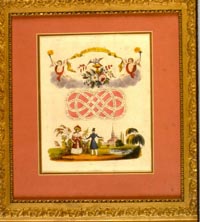Valentines: The Art of Romance
This exhibition offers a wide selection of St. Valentine's Day greeting cards, postcards and elaborate three-dimensional fold-outs from the United States and Europe. The exhibition includes exquisite lace paper valentines, many fine examples of embossed designs, hand-made valentines, even Rebus-puzzle valentines. Ranging from the early 19th century to the 1930's, this exhibit shows the development of the valentine from the simple hand-designed missive to the lacy, almost extravagant valentines of later years.
The celebration of St. Valentine's Day has changed over the years according to differing social mores and customs, and this collection of valentines is a veritable survey of changing taste--more than anything else, the exhibition offers glimpses of American and British life during the 19th and 20th century, and shows how ideas of romance and courtship were expressed during a less complicated era.
During the 1840's the quarto, a letter-size sheet, was the most common form of valentine. Generally the cards had borders, often elegantly embossed, that were decorated with elaborate print or lace work and contained a lithograph or hand-painted picture in the center. Cards produced during the early 20th century lacked both the physical and spiritual characteristics of those produced earlier. Even the sentimental cards were far less elaborate and ardent. Today's joke cards are far less offensive than those produced in former years, and are much more subtle.
Approximately 100 framed groups of Valentine's Day greeting cards and postcards, as well as a number of elaborate fold-out valentines in Plexiglas cases complete this exhibition.




